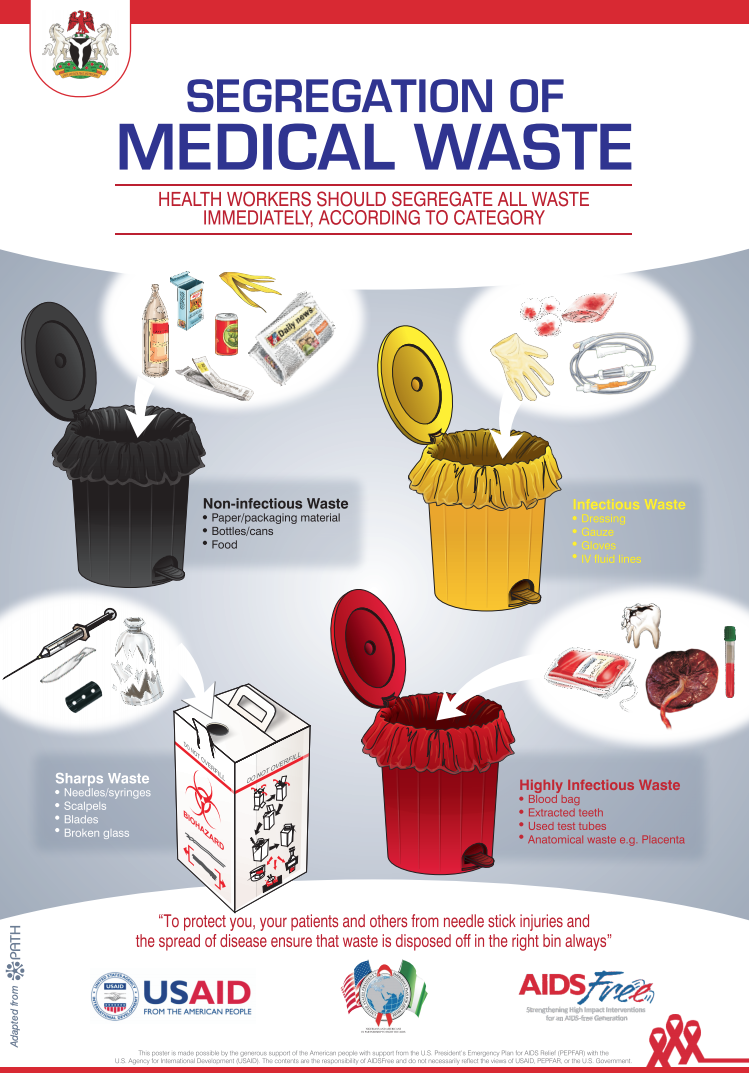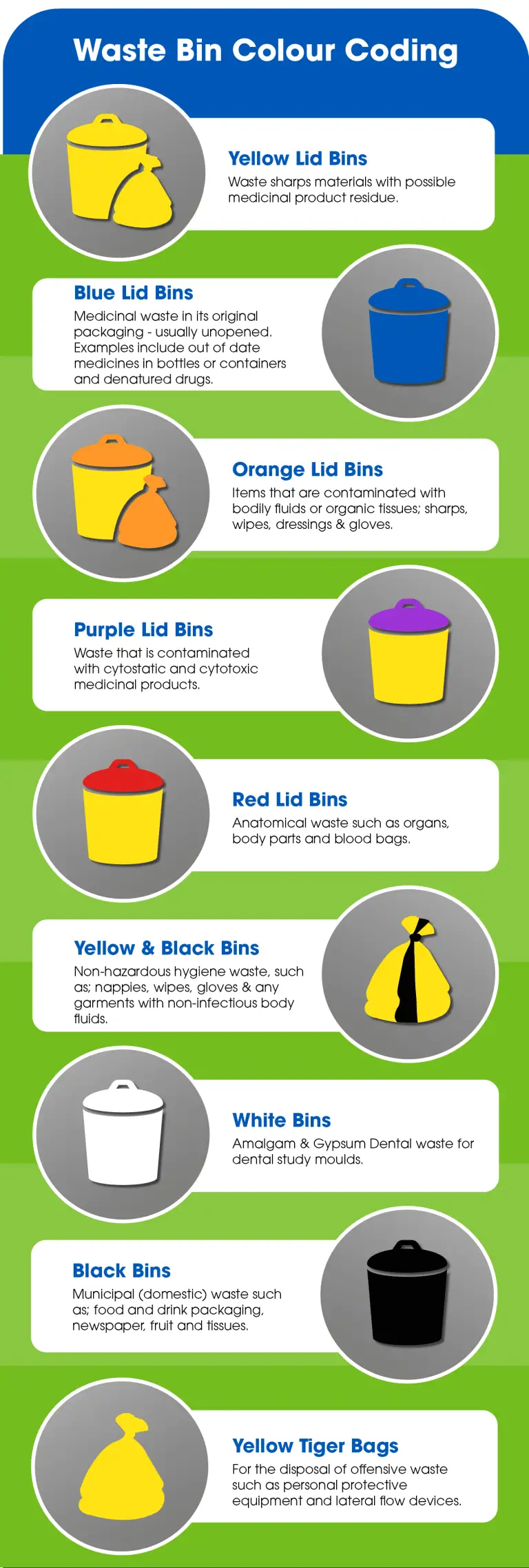Compliant and Reliable Medical Waste Removal Service: Partnering for a Cleaner Future
Wiki Article
Best Practices for Medical Waste Management
Medical waste administration is a critical element of health care centers' operations to make certain the safety and security of people, staff, and the setting. Carrying out ideal practices in medical waste monitoring is important to minimize the dangers linked with hazardous waste.Partition and Categorization
In the area of clinical waste administration, appropriate partition and categorization are crucial techniques for making certain the safe and efficient disposal of healthcare-related materials. Medical waste is generated from numerous sources, consisting of health centers, clinics, research laboratories, and various other health care centers. It includes a variety of items, such as needles, syringes, plasters, handwear covers, and pharmaceutical waste.Segregation involves the methodical separation of various kinds of clinical waste based on their characteristics and potential risks. This procedure aids to stop cross-contamination and makes certain that each kind of waste is managed properly. Sharps waste, such as blades and needles, ought to be put in puncture-resistant containers to stop injuries and the spread of infectious diseases. Contagious waste, such as blood-soaked plasters or societies, need to be set apart and dealt with independently to minimize the risk of spreading pathogens.
Categorization is the procedure of identifying clinical waste right into different categories based on its potential threats. WasteX Medical Waste Disposal. These classifications may consist of transmittable waste, hazardous waste, pharmaceutical waste, and basic waste. By classifying waste, medical care facilities can determine the ideal disposal techniques and guarantee compliance with neighborhood guidelines and guidelines
Proper partition and categorization of medical waste not just safeguard the health and wellness of health care workers and the basic public but additionally contribute to the total effectiveness and efficiency of waste monitoring. It minimizes the risk of crashes, reduces ecological influences, and advertises responsible garbage disposal practices.
Correct Storage and Labeling
To make sure the safe and effective disposal of medical waste, healthcare facilities need to follow proper storage space and labeling techniques. Appropriate storage and labeling play a critical duty in maintaining the integrity of medical waste monitoring systems and protecting the health and security of healthcare workers, people, and the basic public.When it pertains to storage space, it is important to have actually designated areas especially designed for different sorts of clinical waste. These locations ought to be protected, well-ventilated, and outfitted with appropriate containers that satisfy regulative criteria. Segregation and classification of waste must additionally be thought about to avoid cross-contamination and prospective dangers.
In addition, correct labeling is crucial for reliable waste monitoring - medical waste removal service. Each container should be plainly classified with the proper signs, color-coding, and info about the waste it contains.
Routine tracking and evaluation of storage areas and containers are important to identify any kind of concerns or infractions. Staff should be trained on proper storage space and labeling techniques, highlighting the value of compliance with procedures and policies.
Safe Transportation and Handling
Making sure the correct and safe transportation and handling of clinical waste is critical for preserving the integrity of waste monitoring systems and securing the health and wellness of all involved. Clinical waste, which includes products infected with infectious products, drugs, and other dangerous substances, must be transferred in a fashion that protects against leaks, spills, and possible contamination.To achieve risk-free transportation and handling, a number of best methods should be complied with. Initially, it is vital to use puncture-resistant and leak-proof containers that are particularly designed for clinical waste. These containers should be properly secured and labeled to prevent any kind of unintentional direct exposure or mishandling. In addition, waste ought to be set apart based upon its nature and kind to avoid cross-contamination.
During transportation, it is crucial to make sure that waste containers are firmly fastened and stored in a stable way. Cars made use of for transporting medical waste should be geared up with suitable security attributes, such as spill control systems, to decrease the risk of any spills or leaks (medical waste removal service). Drivers should receive training on proper handling and emergency action treatments to successfully attend to any type of unanticipated occurrences
Moreover, the transportation and handling of medical waste should comply with all relevant regulations and standards stated by regional, state, and federal authorities. Regular examinations and audits need to be carried out to evaluate compliance and recognize any kind of areas for enhancement.

Conformity With Regulatory Guidelines
Maintaining conformity with governing standards is crucial for reliable medical waste management. These standards are established to shield public wellness and the atmosphere by ensuring that clinical waste is correctly dealt with, dealt with, and disposed of. medical waste removal. Compliance with regulatory standards helps to avoid the spread of contagious diseases, reduce possible dangers, and reduce the general impact of clinical waste on the environmentTo accomplish compliance, health care centers should stay informed regarding the specific guidelines governing medical waste monitoring in their jurisdiction. These guidelines may vary from nation to nation, and even within various states or regions. It is vital for medical care centers to have a thorough understanding of these guidelines and to execute ideal approaches and protocols to make sure conformity.
One key element of conformity is the proper segregation and labeling of different sorts of clinical waste. This consists of separating sharps from other waste, in addition to classifying waste based on its potential dangers. Medical care centers should likewise make certain that medical waste is kept in proper containers which these containers are correctly identified and secured.
In addition, conformity with regulatory guidelines requires health care facilities to develop proper training and education programs for personnel associated with clinical waste monitoring - WasteX Medical Waste Disposal. This consists of supplying training on waste segregation, taking care of, and disposal procedures, along with the appropriate use personal protective equipment
Normal surveillance and audits are additionally crucial to make certain ongoing compliance with regulatory standards. This includes carrying out regular evaluations of waste storage space locations, recording waste monitoring treatments, and preserving documents of waste disposal.
Effective Disposal Methods
Medical care centers should employ reliable disposal techniques for proper management of medical waste - WasteX Medical Waste Disposal. Inappropriate disposal of medical waste can posture major health and ecological risks. There are a number of methods that can be utilized to effectively deal with clinical waste, making sure the safety of medical care workers, individuals, and the publicOne generally used technique is incineration. Incinerators can safely melt medical waste at heats, lowering the volume and destroying any type of possibly damaging virus. Incineration can be expensive and may release unsafe pollutants into the air if not appropriately managed.
One more approach is autoclaving, which involves subjecting the waste to high-pressure heavy steam. This procedure kills germs, viruses, and various other bacteria, rendering the waste risk-free for disposal in normal waste streams. Autoclaving is a effective and eco-friendly method, but it needs customized devices and trained employees.
Chemical disinfection is likewise made use of in some instances, where liquid chemicals are put on the waste to disinfect it. This technique is much less commonly utilized because of problems about the effectiveness of chemical disinfection and the capacity for chemical deposits to infect the environment.
In addition to these methods, health care facilities need to my website additionally implement proper segregation, packaging, and labeling of medical waste to ensure its risk-free handling and disposal. Routine training and education of personnel on appropriate waste administration methods are essential to maintaining effective disposal methods.
Conclusion

Medical waste monitoring is an important element of healthcare centers' operations to make certain the security of patients, team, and the atmosphere. Implementing finest practices in clinical waste management is crucial to lessen the risks associated with unsafe waste. These categories might include infectious waste, harmful waste, pharmaceutical waste, and general waste.In final thought, implementing finest practices for medical waste monitoring is vital for ensuring the safety and security of healthcare employees, patients, and the setting. By correctly categorizing and setting apart waste, storing and identifying it appropriately, ensuring risk-free transport and handling, complying with regulative standards, and using effective disposal techniques, medical care facilities can successfully take care of and minimize the risks connected with clinical waste.
Report this wiki page